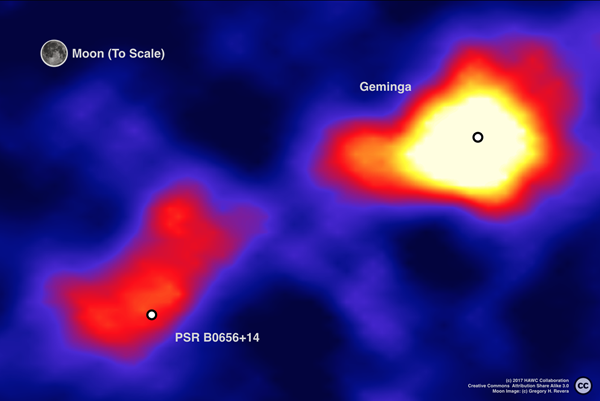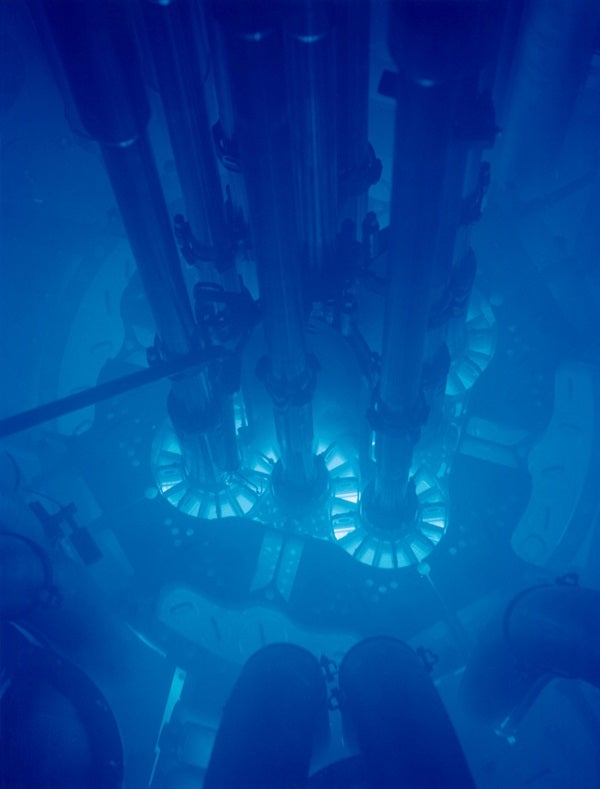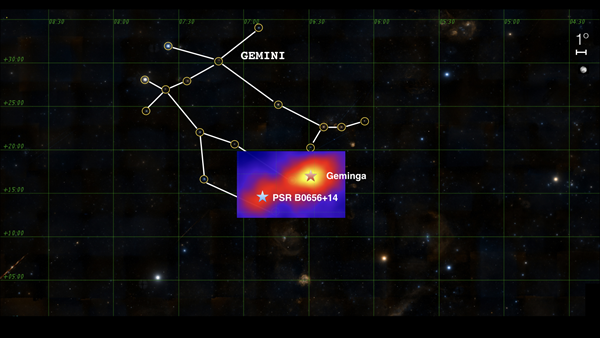New results from an unconventional observatory in Mexico are bringing scientists one step closer to solving the dark matter mystery. They lend credence to the idea that some strange non-light-emitting particle is responsible for about 85% of the universe’s mass. This new observation casts serious doubt on the more conventional of two favored theories for the enigmatic excess of antimatter particles in space, leaving dark matter particles as the most likely explanation.
The origin of this mystery dates back to 2008, when the European PAMELA satellite first registered an unexpectedly high number of positrons in near-Earth space. Positrons can be thought of as positively charged electrons, or the antimatter counterparts to electrons. More recently, the Alpha Magnetic Spectrometer (AMS) experiment aboard the International Space Station has extended PAMELA’s finding, seeing roughly three to five times more positrons than scientists predicted.
Theorists came up with two logical explanations for the excess positrons. The more prosaic explanation says that rapidly rotating neutron stars (pulsars) are violently throwing off positrons and other subatomic particles, some of which make their way to Earth. But other scientists proposed a more exotic alternative: that very heavy dark matter particles pervading our galaxy mutually annihilate one another whenever they come into close proximity, self-destructing into a cascade of positrons and other elementary particles.
To test the pulsar hypothesis, an international team of scientists observed the sky with the High-Altitude Water Cherenkov (HAWC) Observatory. This is not your ordinary observatory with one or more astronomical telescopes. HAWC instead consists of 300 large water tanks stationed at an altitude of 13,500 feet in the southern Mexican state of Puebla.
The origin of this mystery dates back to 2008, when the European PAMELA satellite first registered an unexpectedly high number of positrons in near-Earth space. Positrons can be thought of as positively charged electrons, or the antimatter counterparts to electrons. More recently, the Alpha Magnetic Spectrometer (AMS) experiment aboard the International Space Station has extended PAMELA’s finding, seeing roughly three to five times more positrons than scientists predicted.
Theorists came up with two logical explanations for the excess positrons. The more prosaic explanation says that rapidly rotating neutron stars (pulsars) are violently throwing off positrons and other subatomic particles, some of which make their way to Earth. But other scientists proposed a more exotic alternative: that very heavy dark matter particles pervading our galaxy mutually annihilate one another whenever they come into close proximity, self-destructing into a cascade of positrons and other elementary particles.
To test the pulsar hypothesis, an international team of scientists observed the sky with the High-Altitude Water Cherenkov (HAWC) Observatory. This is not your ordinary observatory with one or more astronomical telescopes. HAWC instead consists of 300 large water tanks stationed at an altitude of 13,500 feet in the southern Mexican state of Puebla.
HAWC indirectly picks up very-high-energy gamma rays, the highest-energy form of “light” yet detected in the universe. Each of these gamma rays packs the punch of roughly 10 million dental X-rays. When one of these gamma rays slams into an atom in Earth’s upper atmosphere, it smashes it apart into a shower of secondary particles that rain downward at near-light speed. These minuscule packets of energy pass through HAWC’s water tanks, producing simultaneous flashes of blue light known as Cherenkov radiation after Russian physicist Pavel Cherenkov, who co-discovered this bizarre form of light in 1934.
During observations taken from November 2014 to June 2016, HAWC clearly detected very high-energy gamma rays from the region around two relatively nearby pulsars in Gemini. The pulsars, known as Geminga and PSR B0656+14, are roughly 800 and 900 light-years away, respectively. Detecting such high-energy gamma rays from an extended region around these pulsars was itself a first, made possible by HAWC’s wide field of view. The problem, says team member Miguel Mostafá of Penn State University, is that “the observed flux of gamma rays is not enough to account for the positron excess.”
Each pulsar throws off positrons and electrons, which interact with surrounding photons from the early universe (the cosmic microwave background) to produce gamma rays in an extended region. Unfortunately, scientists cannot trace positrons around Earth back to their point of origin. Because positrons are electrically charged particles, they are deflected by magnetic fields permeating space, meaning they don’t come straight toward us. So HAWC measured the radial extent of gamma-ray emission from each pulsar, which is an indirect measurement of how many positrons are being produced and how fast these particles are moving away from their host pulsar.
Each pulsar throws off positrons and electrons, which interact with surrounding photons from the early universe (the cosmic microwave background) to produce gamma rays in an extended region. Unfortunately, scientists cannot trace positrons around Earth back to their point of origin. Because positrons are electrically charged particles, they are deflected by magnetic fields permeating space, meaning they don’t come straight toward us. So HAWC measured the radial extent of gamma-ray emission from each pulsar, which is an indirect measurement of how many positrons are being produced and how fast these particles are moving away from their host pulsar.
“The gamma rays that we measure are a tracer for the electrons and positrons near the source. Using this, we can map out how fast the electrons and positrons are moving away from the source. Knowing the age and the distance of the pulsars, we can figure out if they can get here,” says HAWC principal investigator and U.S. spokesperson Jordan Goodman of the University of Maryland.
Putting this all together in a paper published in the November 17, 2017 issue of Science, the team concludes that the pulsars aren’t producing anywhere near enough positrons to explain the excess observed by PAMELA and AMS. Because the two pulsars are among the closest to Earth, it seems very clear that pulsars in general cannot account for the anomaly.
So if pulsars can’t explain the positron excess, what can? Some theorists have proposed supernova remnants and black hole jets. HAWC has detected these types of objects, but as Goodman explains, “Most are too far away and too young to send particles all the way to Earth.”
This leaves dark matter particle annihilation as the most likely explanation for the positron excess. This theory has been on the books for many years, and it’s not contradicted by any astronomical observations. Physicists have proposed a number of different types of dark matter particles, with a wide range of properties and masses. If annihilating dark matter is indeed responsible for the positron excess, the particles themselves would have whopping masses of about a thousand protons — approximately the mass of four or five uranium atoms.
Experiments at the Large Hadron Collider in Switzerland and in underground laboratories around the world have yet to turn up direct evidence for dark matter particles. So although HAWC seems to have ruled out pulsars as the source of the excess positrons, their origin remains a mystery, as does the nature of dark matter.
Putting this all together in a paper published in the November 17, 2017 issue of Science, the team concludes that the pulsars aren’t producing anywhere near enough positrons to explain the excess observed by PAMELA and AMS. Because the two pulsars are among the closest to Earth, it seems very clear that pulsars in general cannot account for the anomaly.
So if pulsars can’t explain the positron excess, what can? Some theorists have proposed supernova remnants and black hole jets. HAWC has detected these types of objects, but as Goodman explains, “Most are too far away and too young to send particles all the way to Earth.”
This leaves dark matter particle annihilation as the most likely explanation for the positron excess. This theory has been on the books for many years, and it’s not contradicted by any astronomical observations. Physicists have proposed a number of different types of dark matter particles, with a wide range of properties and masses. If annihilating dark matter is indeed responsible for the positron excess, the particles themselves would have whopping masses of about a thousand protons — approximately the mass of four or five uranium atoms.
Experiments at the Large Hadron Collider in Switzerland and in underground laboratories around the world have yet to turn up direct evidence for dark matter particles. So although HAWC seems to have ruled out pulsars as the source of the excess positrons, their origin remains a mystery, as does the nature of dark matter.













